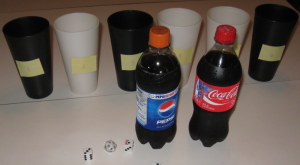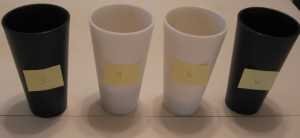nullprogram.com/blog/2008/07/25/
 My fiancee, Kelsey, claimed that she could tell the difference between
Coke and Pepsi. I wanted to put this to the test. Since there were
only two of us, arranging the test wasn't a simple matter of asking
someone else to pour some cups. I also wanted to do this right:
testing must
be
double-blind. I devised a little scheme that allowed us to perform
two different tests.
My fiancee, Kelsey, claimed that she could tell the difference between
Coke and Pepsi. I wanted to put this to the test. Since there were
only two of us, arranging the test wasn't a simple matter of asking
someone else to pour some cups. I also wanted to do this right:
testing must
be
double-blind. I devised a little scheme that allowed us to perform
two different tests.
The first test was seeing if Kelsey or I could determine which
beverage was Pepsi and which was Coke. The second was determining if
there was any distinction in taste between the two drinks at all,
which consisted matching two different samples together. The second
test also acts as a check on the first test.
We bought one bottle of each at CVS. Next, we labeled six different
cups with the numbers one though six. Each odd number is paired with
the following even number. Kelsey, who was alone, used a die with an
even number of sides (this includes a something as simple as a coin
toss) to put one beverage in cup #1 and the other in cup #2. In this
case, we used my 20-sided die I use for Dungeons and Dragons, because
using it for this purpose was just full of win.
The die is important here as a random number generator. If it is left
up to a human to decide what drinks go where, we may bias the
setup. For example, I may be more likely to put Pepsi in an
odd-numbered cup than an even-numbered one.
It is difficult for human beings to behave randomly. Try generating a
list of 50 coin tosses yourself. I mean, without a coin. Just type a
series of 50 H's and T's. If you examine your list of flips, you will
find that you often generate very improbable series of flips
(excessive heads or tails) and exhibit patterns. We need dice or
coins to make decisions for us in this experiment.
To do it right, the beverage must be chosen before the roll: "I will
be pouring Pepsi now.". Roll the die. If it rolls an odd number, pour
the drink into the odd cup (#1). Write this information down and keep
it secret.
 Next, after allowing the foam to calm down (which might accidentally
reveal information to me), Kelsey leaves the room and I enter. I
perform a similar procedure to distribute the drinks into cups #3 and
#4, then #5 and #6. I keep track of what drink, #1 or #2, goes into
what cup. I keep it secret. These last two cups are for the purpose of
the second experiment.
Next, after allowing the foam to calm down (which might accidentally
reveal information to me), Kelsey leaves the room and I enter. I
perform a similar procedure to distribute the drinks into cups #3 and
#4, then #5 and #6. I keep track of what drink, #1 or #2, goes into
what cup. I keep it secret. These last two cups are for the purpose of
the second experiment.
At this point Kelsey knows what was in cups #1 and #2, but not where
they went. I know where they went, but not what was in the
cups. Together we know everything, but individually we know
nothing.
In order to make the second test double-blind, and allow me to
participate, I leave the room. Kelsey rolls the die. If it rolls odd
she switches the label on cups #5 and #6. It is important that these
cups are identical. One flaw potential, however, is that the liquid in
each cup may look unique. One may be more fizzy or one cup a little
more full. Noticing this may happen subconsciously, which is the whole
point of doing double-blind tests.
Ok, we didn't actually do this last part because I didn't think of it
till later.
We sample all four cups (#3 - #6) in pairs, alone, making notes on
what beverage we think is in what cup. Once we are both done we share
our secrets and see how well we did.
Our results? Neither of us could tell the difference between Coke and
Pepsi.